As a new mom, soothing your child is one of your most noteworthy needs, and you may discover a pacifier extremely supportive. Few babies can be mitigated with shaking and snuggling and are substance to suck just amid feedings. Others just can’t suckle enough, notwithstanding when they’re not hungry. If your child still needs to suck even if he just had his milk, a pacifier might just be what he needs. But, what pacifier products should you choose?
In this article, I will share the following information with you: the advantages of a pacifier, how to choose the best pacifiers for newborns, and the list of best pacifiers in the market.
List of The Best Pacifiers In The Market For Newborn Babies
Philips AVENT Soothie Pacifier for Newborns (0-3 Months)

The Philips AVENT Soothie Pacifier is a popular choice among parents for soothing their newborns. Made from medical-grade silicone, it is designed to support oral development while offering a calming and comforting experience. Trusted by medical professionals and distributed in hospitals nationwide, this pacifier is ideal for babies from birth to three months. Its one-piece construction ensures safety, while the soft, flexible silicone mimics the natural feel, making it gentle on your baby’s delicate gums.
Key Features
- Medical-Grade Silicone: Soft, durable, and safe for newborns, made without BPA or latex.
- One-Piece Design: Eliminates the risk of parts breaking off, reducing choking hazards.
- Orthodontic Nipple: Supports healthy oral development with a symmetrical shape.
- Hospital Distributed: Trusted by healthcare professionals and used in hospitals across the country.
- Finger-Held Design: Allows caregivers to place a finger inside for bonding while the baby sucks.
- Easy Cleaning: Can be sterilized using boiling water or a sterilizer.
- Pack of Four: Convenient for parents to have extras on hand.
What We Like
- Medical-grade, BPA-free silicone is safe and gentle.
- Orthodontic design promotes natural oral development.
- Easy to clean and sterilize.
- Widely trusted and used in hospitals.
- Comfortable and soothing for newborns.
What We Don’t Like
- Limited to babies up to three months.
- Some babies may prefer a different shape.
Overall
The Philips AVENT Soothie Pacifier is a well-designed, safe, and effective option for calming newborns. Its medical-grade silicone and one-piece construction provide peace of mind for parents, while the soft, orthodontic nipple supports healthy oral development. Trusted by hospitals and loved by parents, it remains a top choice for newborn soothing.
NUK Comfy Orthodontic Pacifiers for Newborns (0-6 Months)
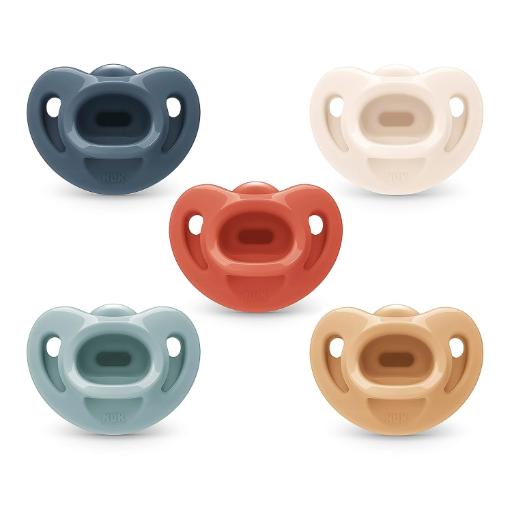
The NUK Comfy Orthodontic Pacifiers are thoughtfully designed for newborns, combining comfort and support for healthy oral development. Made from 100% medical-grade silicone, these pacifiers are gentle on your baby’s delicate skin and are free from BPA. The orthodontic nipple shape naturally conforms to your baby’s palate, promoting proper oral health. With a heart-shaped shield that comfortably sits under the baby’s nose, these pacifiers allow for easy breathing and reduce irritation.
Key Features
- Orthodontic Design: Helps promote healthy oral development with a nipple that mimics the natural shape of a mother’s breast.
- Medical-Grade Silicone: Soft, durable, and safe for newborns, made without BPA.
- One-Piece Construction: Reduces the risk of parts breaking off, enhancing safety.
- Heart-Shaped Shield: Fits comfortably under the nose, allowing unrestricted breathing.
- Easy to Clean: Dishwasher safe (top rack) and boilable for thorough sterilization.
- Versatile Pack: Comes in a set of five, offering variety in colors and designs.
What We Like
- Made from high-quality, medical-grade silicone.
- Promotes oral health with an orthodontic shape.
- Soft and comfortable for the baby’s sensitive skin.
- Variety of colors and styles in a single pack.
- Dishwasher safe and easy to sterilize.
What We Don’t Like
- Can attract dust and lint if dropped.
- Does not include a storage case.
Overall
The NUK Comfy Orthodontic Pacifiers are an excellent choice for parents looking for safe and comfortable pacifiers that support oral health. Their ergonomic design and soft silicone make them gentle on the baby’s skin, while the variety of colors adds a fun touch. Despite minor drawbacks, these pacifiers offer great value and are highly recommended for newborns.
Tommee Tippee Ultra-Light Silicone Pacifier for Newborns (0-6 Months)
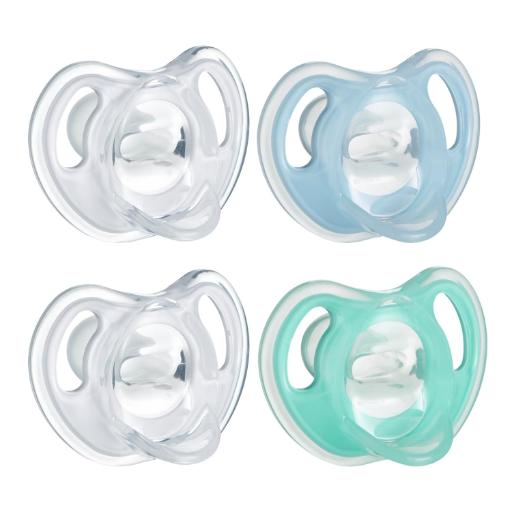
The Tommee Tippee Ultra-Light Silicone Pacifier is crafted to provide maximum comfort while minimizing the risk of falling out. Its lightweight, one-piece silicone design ensures that it stays securely in the baby’s mouth, reducing exposure to germs. The symmetrical nipple promotes a natural feel and is designed to fit comfortably regardless of orientation. With a BPA-free construction, this pacifier is safe for newborns and provides a gentle experience for sensitive skin.
Key Features
- Ultra-Lightweight Design: Stays in place to minimize germs from falling on the ground.
- Symmetrical Nipple: Always the right way up, promoting soothing comfort.
- Skin-Friendly Air Holes: Reduces skin irritation and allows for breathability.
- Curved Shield: Ensures a snug fit between the baby’s nose and chin.
- One-Piece BPA-Free Silicone: Safe, durable, and easy to clean.
- Pack of Four: Comes in clear, blue, and green colors for variety.
What We Like
- Extremely lightweight, making it easy for babies to keep in their mouths.
- The symmetrical nipple reduces the chance of discomfort.
- Durable and safe silicone construction.
- Air holes help prevent skin irritation.
- Simple to sterilize and maintain.
What We Don’t Like
- Lacks a loop for attaching a pacifier clip.
- Some parents find it tricky to secure due to its smooth texture.
Overall
The Tommee Tippee Ultra-Light Silicone Pacifier is an excellent option for parents looking for a lightweight and comfortable pacifier that stays put. Its thoughtful design supports healthy oral development while minimizing irritation. Despite minor drawbacks, it remains a favorite for soothing newborns effectively.
Philips AVENT Soothie Heart Pacifier for Newborns (0-3 Months)
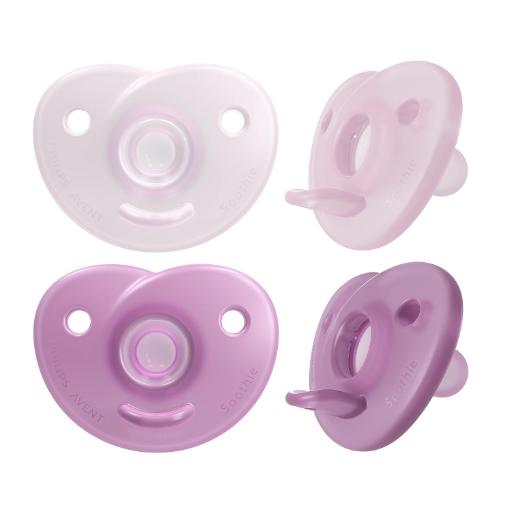
The Philips AVENT Soothie Heart Pacifier is trusted by medical professionals and widely used in hospitals to soothe newborns. Its heart-shaped shield offers added comfort and better fit, allowing for easy breathing without obstructing the baby’s nose. Made from BPA-free medical-grade silicone, this pacifier is safe and gentle on delicate newborn skin. The one-piece construction eliminates any risk of small parts breaking off, making it a reliable choice for parents.
Key Features
- Medical-Grade Silicone: Soft, durable, and BPA-free, ensuring safety and comfort for babies.
- Heart-Shaped Shield: Unique design offers a snug fit while keeping the nose area clear.
- One-Piece Design: Reduces choking risks and enhances durability.
- Hospital Trusted: Widely distributed in hospitals across the country.
- Easy Maintenance: Dishwasher safe and can be sterilized for hygiene.
- Pack of Four: Comes in pink/light pink color, suitable for newborns.
What We Like
- Safe and soft medical-grade silicone material.
- Unique heart shape designed for comfort and easy breathing.
- One-piece design minimizes breakage risk.
- Easy to clean and sterilize.
- Trusted by healthcare professionals.
What We Don’t Like
- Limited to newborns up to 3 months.
- Some babies may have difficulty keeping it in the mouth.
Overall
The Philips AVENT Soothie Heart Pacifier is a thoughtful blend of comfort and safety, making it an ideal choice for newborns. Its heart-shaped design sets it apart by allowing better airflow around the nose, while the soft silicone material is gentle on sensitive skin. Highly recommended for parents looking for a reliable, hospital-grade pacifier.
MAM Original Day & Night Pacifiers for Newborns (0-6 Months)
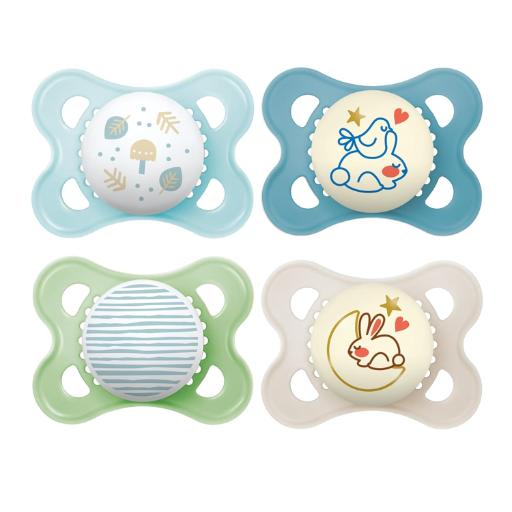
The MAM Original Day & Night Pacifiers are thoughtfully crafted for newborns, providing a soothing experience with a unique glow-in-the-dark feature. Designed with medical expertise, these pacifiers promote healthy oral development thanks to their symmetrical nipple. Made from BPA-free silicone, they are soft, flexible, and comfortable for delicate newborn skin. The curved shield design ensures proper airflow, minimizing skin irritation, while the night versions make it easy to find in the dark.
Key Features
- Glow-in-the-Dark Feature: Makes it easy to find at night, reducing sleep disruptions.
- Symmetrical Nipple: Supports jaw and teeth development, ideal for newborns.
- SkinSoft Silicone: Soft, durable, and accepted by 94% of babies.
- Ventilated Shield: Reduces skin irritation by allowing air circulation.
- BPA & BPS Free: Safe for babies, meeting high safety standards.
- Sterilizer Box Included: Convenient for easy and hygienic sterilization.
- Pack of Four: Includes both day and night pacifiers with cute designs.
What We Like
- Glow-in-the-dark feature for easy nighttime retrieval.
- Symmetrical nipple designed for healthy oral development.
- Soft, flexible silicone that feels natural and soothing.
- Ventilated shield prevents moisture buildup.
- Easy to clean and sterilize.
What We Don’t Like
- Glow effect may fade quickly.
- Some parents find the nipple shape too narrow.
Overall
The MAM Original Day & Night Pacifiers are a great option for parents seeking comfort and convenience. The glow-in-the-dark feature is especially useful for nighttime soothing, while the soft silicone material and ergonomic design ensure a pleasant experience for newborns. Despite minor drawbacks, these pacifiers are highly recommended for their practicality and comfort.
Tommee Tippee Breast-Like Pacifier for Newborns (0-6 Months)
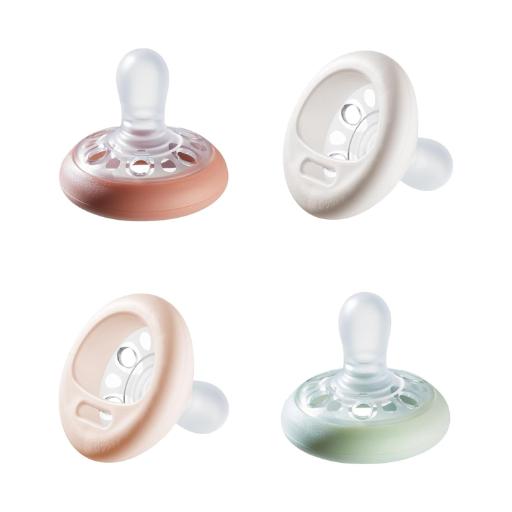
The Tommee Tippee Breast-Like Pacifier is specifically designed to mimic the feel and shape of a mother’s breast, making it ideal for transitioning between breastfeeding and soothing. Made from soft, BPA-free silicone, the pacifier’s symmetrical nipple supports natural oral development and reduces the risk of nipple confusion. The comfortable shield with air holes promotes breathability and prevents skin irritation, while the one-piece design enhances safety and durability.
Key Features
- Breast-Like Design: Mimics the natural feel of a mother’s breast for a comfortable transition.
- Symmetrical Nipple: Supports natural oral development and stays properly positioned.
- Soft Silicone Material: Gentle on newborn gums and free from BPA and BPS.
- Airflow Holes: Helps keep the baby’s skin dry and prevents irritation.
- One-Piece Construction: Reduces the risk of parts breaking off, ensuring safety.
- Pack of Four: Includes assorted colors (pink, green, cream).
What We Like
- Ideal for breastfed babies due to its breast-like design.
- Soft, durable silicone is gentle on gums.
- Air holes prevent skin irritation.
- Symmetrical nipple reduces nipple confusion.
- Easy to clean and sterilize.
What We Don’t Like
- Nipple size may be too large for smaller newborns.
- Some parents find it doesn’t stay in the mouth easily.
Overall
The Tommee Tippee Breast-Like Pacifier is a great option for parents who want a pacifier that closely mimics the feel of breastfeeding. Its soft silicone and symmetrical design make it comfortable and practical for newborns, although the nipple size may not suit all babies. Overall, it’s a reliable choice for soothing breastfed infants.
Philips Avent Ultra Air Pacifier for Newborns (0-6 Months)
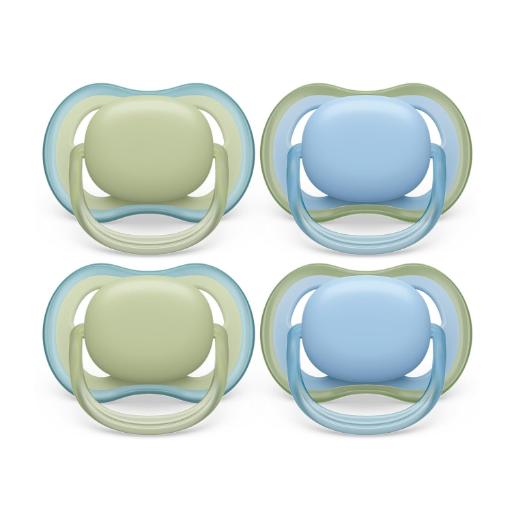
The Philips Avent Ultra Air Pacifier is designed to keep your baby’s skin dry and comfortable with extra-large air holes that promote airflow. Made from soft, BPA-free silicone, this pacifier offers a lightweight and breathable experience, ideal for sensitive skin. The orthodontic symmetrical nipple supports healthy oral development, while the included sterilizer case makes cleaning a breeze. Trusted by parents and loved by babies, this pacifier is perfect for soothing your newborn.
Key Features
- Ultra Airflow Design: Large air holes keep baby’s skin dry and reduce irritation.
- Orthodontic Nipple: Supports healthy oral development with a symmetrical silicone shape.
- Soft and Flexible: Gentle on the baby’s gums, made from BPA-free silicone.
- Sterilizer Case Included: Convenient for cleaning and on-the-go use.
- High Acceptance Rate: 98% of babies accept the nipple shape.
- Pack of Four: Includes pastel green and celestial blue colors.
What We Like
- Lightweight and breathable design for sensitive skin.
- Orthodontic nipple promotes natural oral development.
- Soft silicone is comfortable and easy to clean.
- Comes with a sterilizer travel case for convenience.
- Great for soothing newborns without causing irritation.
What We Don’t Like
- Some moisture may get trapped in the nipple after sterilization.
- May not stay in the mouth as securely as heavier designs.
Overall
The Philips Avent Ultra Air Pacifier is an excellent choice for parents looking for a breathable, lightweight pacifier that supports oral health. The soft silicone nipple is gentle and widely accepted by babies, while the included sterilizer case makes cleaning hassle-free. Ideal for keeping your baby calm and comfortable.
MAM Original Start Pacifier for Newborns (0-3 Months)
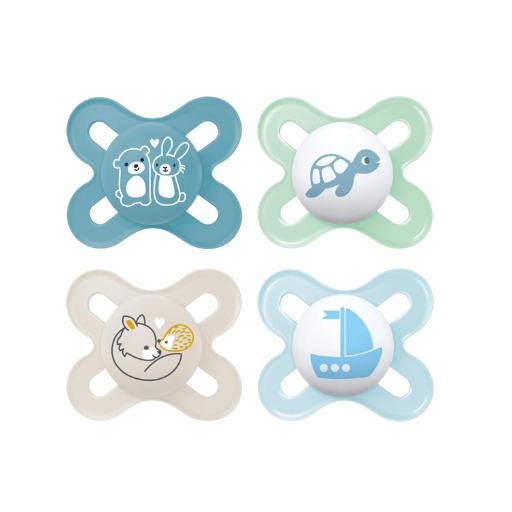
The MAM Original Start Pacifier is designed specifically for newborns, offering a soft, lightweight, and skin-friendly experience. Developed with medical experts, it features a symmetrical nipple that promotes healthy oral development. Made from BPA-free silicone, the pacifier has a SkinSoft textured nipple that feels natural, helping babies accept it easily. The curved shield with ventilation holes keeps the baby’s skin dry and comfortable, minimizing irritation.
Key Features
- Symmetrical Nipple: No need to worry about orientation, promoting healthy oral development.
- SkinSoft Silicone: Soft and natural feel, ideal for soothing newborns.
- Ventilated Shield: Prevents moisture buildup and allows airflow to reduce skin irritation.
- BPA-Free Material: Safe for newborns, made from high-quality silicone.
- High Acceptance Rate: Accepted by 94% of babies due to its natural texture.
- Pack of Four: Includes colors like sky blue, pale mint, and shell.
What We Like
- Symmetrical design ensures proper placement.
- Soft silicone nipple mimics the feel of breastfeeding.
- Ventilation holes reduce skin irritation and rashes.
- Lightweight and easy to clean.
- Comes with a sterilizer box for convenience.
What We Don’t Like
- Some moisture may get trapped after washing.
- Not ideal for older infants due to its small size.
Overall
The MAM Original Start Pacifier is a top choice for newborns, offering comfort and safety with its soft, natural-feeling nipple and ventilated shield. Its ergonomic design and high acceptance rate make it a reliable option for parents. Despite minor issues with moisture retention, it remains a trusted choice for soothing newborns.
Philips Avent Soothie Pacifier for Babies (3-18 Months)
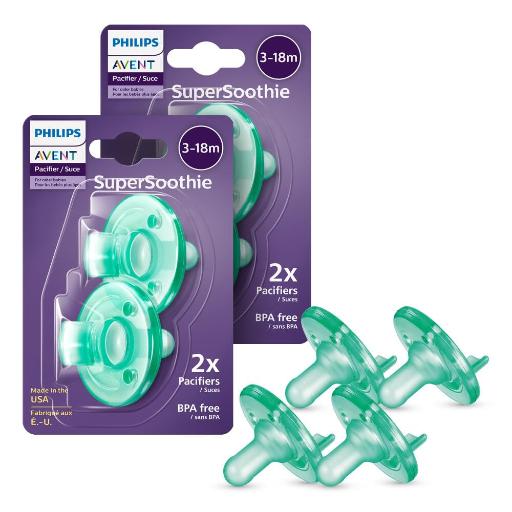
The Philips Avent Soothie Pacifier is a trusted choice for parents and medical professionals alike, widely used in hospitals to soothe babies. Made from 100% medical-grade silicone, it is designed to promote natural oral development with a symmetrical, collapsible nipple. The one-piece construction ensures durability and safety, while the soft, flexible material mimics the natural feel of breastfeeding. The finger-held design allows caregivers to bond with their baby while soothing them.
Key Features
- Medical-Grade Silicone: Safe, durable, BPA-free, and latex-free.
- Orthodontic Nipple: Symmetrical shape supports healthy oral development.
- One-Piece Design: Reduces choking hazards and enhances safety.
- Finger-Held Feature: Allows for bonding and comfort.
- Hospital Distributed: Trusted by healthcare professionals nationwide.
- Easy to Clean: Can be sterilized or boiled for hygiene.
- Pack of Four: Includes green-colored pacifiers.
What We Like
- Soft and flexible medical-grade silicone.
- Symmetrical nipple promotes natural oral health.
- Safe, durable, and easy to maintain.
- Ideal for bonding due to the finger-held design.
- Widely used and trusted by hospitals.
What We Don’t Like
- Temporarily out of stock.
- Some parents find the nipple a bit firm for younger infants.
Overall
The Philips Avent Soothie Pacifier is a reliable and safe choice for soothing babies aged 3-18 months. Its medical-grade construction and thoughtful design make it a top choice among parents and healthcare providers. Despite being temporarily out of stock, it remains a popular and trusted option for calming babies.
MAM Newborn Pacifier Variety Pack (0-3 Months)

The MAM Newborn Pacifier Variety Pack is specially designed to cater to newborns, offering three distinct pacifiers to meet different soothing needs. Each pacifier is made from BPA-free, medical-grade silicone and features MAM’s signature SkinSoft textured nipple, which mimics the natural feel of breastfeeding. Lightweight and ergonomically designed, these pacifiers help reduce the risk of nipple confusion while promoting oral health. The curved shield with ventilation holes ensures proper airflow, keeping the baby’s skin dry and comfortable.
Key Features
- Variety Pack: Includes three different pacifiers (MAM Comfort, MAM Perfect Start, and MAM Original Start).
- Lightweight Design: 32% lighter than similar silicone pacifiers, making it easy for newborns to hold.
- SkinSoft Silicone Nipple: Mimics breastfeeding, increasing acceptance by babies.
- Symmetrical Shape: Ensures correct placement without needing adjustment.
- Ventilated Shield: Keeps the baby’s skin dry and reduces moisture buildup.
- BPA-Free and BPS-Free: Safe and gentle on the baby’s mouth.
What We Like
- Variety of pacifiers to suit different preferences.
- Soft and lightweight, comfortable for newborns.
- Reduces nipple confusion with its natural feel.
- Easy to clean and sterilize.
- Durable and approved by 94% of babies.
What We Don’t Like
- Does not include a sterilizer case.
- Some parents find the glow-in-the-dark feature not bright enough.
Overall
The MAM Newborn Pacifier Variety Pack is an excellent choice for parents looking to provide comfort to their newborns with safe, gentle, and high-quality pacifiers. Its lightweight design and natural feel make it especially suitable for breastfeeding babies, while the variety ensures that parents can find the best fit for their child’s needs.
Parts Of A Pacifier
Ordinary pacifiers are comprised of three separate parts.
1. Nipple
The nipple is put inside your infant’s mouth and sucked on. It provides a recognizable solace that is connected with nourishing time.
2. Guard
The guard keeps your infant from drawing the entire areola into the mouth, which could bring about a potential gagging peril.
3. Ring
The ring, or handle, gives you a dribble freehold utilized when you have to expel the pacifier from your infant’s mouth.
A pacifier isn’t a substitute for supporting or encouraging, obviously, however in the event that your infant is still particular after you’ve nourished, burped, snuggled, shaken, and played with her, you might need to check whether a pacifier will fulfill her.
Things To Consider When Choosing The Nipple
A portion of the great things pacifiers can accomplish for your child – and you – include:
1. SIDS Low Risks
Pacifier use amid rests or evening can avoid sudden newborn child demise disorder. Specialists aren’t sure how it functions; however, in the event that you give your child a pacifier while she’s sleeping, you may bring down her danger of SIDS by the greater part.
2. Fulfill the suck reflex
Babies have a characteristic needs to suck. The jug or bosom ordinarily addresses this issue, yet the craving can wait even after the paunch is full. A pacifier can offer assistance. Simply make certain it doesn’t supplant mealtime.
3. Urge infant to self-calm
Pacifiers can help babies figure out how to control their sentiments, unwind them, and make them feel secure. The solace variable can be a twofold win: A more settled infant can mean more quiet guardians.
Step By Step Instructions To Deal With Your Child’s Pacifier Utilize
On the off chance that you choose to present a pacifier, remember these rules:
1. Give your infant a chance to control your choice
On the off chance that she takes to it immediately, fine. Be that as it may, on the off chance that she opposes, don’t drive it. You can attempt again some other time or simply regard her inclination and let it go.
2. Offer the pacifier between feedings when you know he’s not hungry
Abstain from utilizing a pacifier to defer your infant’s feedings or as a substitute for your consideration. All things considered, now and again your child has to hold up to be bolstered or support. On these occasions, a pacifier can be a boon.
3. Have a go at giving your infant the binky at rest time and sleep time.
Be that as it may, on the off chance that it drops out of her mouth while she’s resting, don’t return it in. When your child’s fastidious, first attempt to solace her in different courses, for example, snuggling, shaking, or singing.
4. Try not to tie a pacifier around your infant’s neck or to his lodging.
He could choke in the line of lace. It’s sheltered to join the pacifier to his garments with a clasp made particularly for the employment.
5. Deal with the pacifier.
Pick a pacifier that is protected and suitable for your child, and keep it clean by washing it with warm water. Supplant it when it hints at little splits or other wear.
6. Try not to “clean” a pacifier by placing it in your mouth.
The American Dental Association says grown-up salivation contains microscopic organisms that can bring about pits in your child’s teeth when they start to emit from her gums.
When Not To Give a Pacifier To An Infant
Try not to give a pacifier to an infant who is having issues putting on weight. So if your infant is experiencing issues nursing or in case you’re experiencing difficulty keeping up your drain supply, it’s presumably best to manage without a pacifier, in any event for the present. You’ll likewise need to consider having your child abandon a pacifier if he’s had rehashed ear contaminations.
In any case, if you have an untimely newborn child who’s not putting on enough weight, a pacifier likely won’t have quite a bit of an impact somehow. Furthermore, utilizing a pacifier may really shield preemies from SIDS, so talk it over with his specialist before decision it out.
If you don’t need your infant to have a pacifier at the healing center, tell the medical attendants early – particularly if you are expected to breastfeed. Despite the fact that a day or two of pacifier use in the healing facility won’t be propensity framing, it just doesn’t bode well to acquaint something you aren’t running with use at home.
Does A Pacifier Affect Teeth Development?
Children are probably not going to harm their teeth, jaw, or nibble on the off chance that they quit utilizing a pacifier when they’re 2 or 3 years of age – and your youngster likely won’t be grinding away for that long. Amid the years that most children utilize a pacifier, they have just their infant’s teeth.
All things considered, the more drawn out your tyke utilizes a pacifier, the more prominent the shot it will influence dental advancement. On the off chance that you ever turned out to be worried about this, ask your tyke’s specialist or dental specialist to ensure your youngster’s jaw and teeth are doing fine.
How To Choose The Best Pacifier
Take note of the following tips for choosing the best pacifiers for newborns.
1. Time
Put aside an opportunity to acquaint your child with the pacifier. It ought to be after your child has been bolstered yet not very near the following feast.
2. Temperament
The following variable you have to overcome is your child’s state of mind. Present the pacifier when your child is feeling quiet and substance. In the event that your baby is vexed or crying, hold off until his disposition makes strides.
3. Touch
With time and temperament are dealt with the time has come to acquaint your infant with the pacifier. Touch the pacifier to your infant’s cheek, only somewhat additionally once more from the side of the mouth. Your infant ought to instinctually turn towards the pacifier and start to suckle.
Appears to be straightforward, isn’t that so? Tragically not all children quickly take to a pacifier. The following are a portion of the reasons why babies decline to utilize a pacifier.
4. Taste
Your infant may at first reject the pacifier areola in light of the fact that the taste is new and confounding. Take a stab at plunging the pacifier in bosom drain or recipe before presenting it. Once your infant relates the pacifier with a natural and consoling taste he may just never surrender it.
5. Type
You are now mindful of this however your little child is a special person. Because one kind of pacifier was worshiped by another infant does not mean your child will be a take to it. Explore different avenues regarding a couple of various pacifiers before quit. You may find that your infant is dismissing the pacifier in light of the surface, shape, or even shading!
If your child opposes utilizing a pacifier then don’t drive it, just attempt again at a later date. In the event that your child still denies the pacifier after various endeavors then you may need to regard your infant’s decision and locate a substitute solution for keep your infant quiet and substance.
Pacifier Replacement
Nipples will in the end wear out after using for quite a while. How rapidly the pacifier should be supplanted will rely on how enthusiastically and how regularly your infant sucks the pacifier.
Signs that the Pacifier Should be Change
- Gaps or tears in the nipple.
- Stained zones.
- The nipple is stretched.
- Plastic has turned barbed on the watch or handle.
- A bit of the pacifier is loose.
- The nipple is sticky, even after altogether washing.
Search for these notice signs every single time you offer a pacifier to your child. Make certain to pull on the nipple every once in a while to ensure that it is still solidly appended to the base. If you don’t supplant pacifiers as they age then you chance the nipple or some other part of the pacifier severs when sucked, you are putting your infant at danger of gagging. Luckily most pacifiers are very shabby to buy and won’t put a gouge in your wallet.
Cleaning The Pacifiers
Unless the bundling states else, you can clean the lion’s share of child pacifiers a similar way you clean your infant bottles and sippy glasses. The sanitization procedure is precisely the same too.
After you have cleaned your pacifier you may see that there is still water or buildup inside the nipple. This is ordinary. For whatever length of time that you have crushed however much water out of the pacifier as areola as could reasonably be expected, this will in the long run dry out. Essentially leave the areola in a dry, very much ventilated territory.
Utilizing various pacifiers can be a favorable position as you can swap pacifiers over while permitting the pacifiers you have washed satisfactory time to dry.
Continuously wash and clean a fresh out-of-the-box new pacifier before acquainting it with your infant. This should be done every last time you purchase another pacifier.
Frequently Asked Questions (FAQs)
It is recommended to replace pacifiers every 4-6 weeks, or sooner if they show signs of wear, damage, or discoloration. Regular replacement ensures hygiene and safety for your baby.
Pacifiers with a breast-like shape, such as those from Tommee Tippee, are designed to minimize nipple confusion. Introducing a pacifier after breastfeeding is well established (usually after a few weeks) can also help reduce this risk.
Most silicone pacifiers can be boiled for five minutes or placed in a sterilizer. Some models come with a sterilizer box for added convenience. Always check the manufacturer’s instructions for specific cleaning methods.
Orthodontic pacifiers are designed to support natural oral development and reduce pressure on the gums and teeth. They are a great choice if you’re concerned about your baby’s dental health.
Yes, glow-in-the-dark pacifiers like those from MAM are generally safe. The glowing effect is achieved through non-toxic materials. However, the glow may fade over time, especially after frequent sterilization.
Conclusion
Choosing the best pacifier for your newborn involves considering factors like material, design, comfort, and ease of cleaning. Brands like Philips Avent, MAM, NUK, and Tommee Tippee offer well-designed pacifiers that cater to the unique needs of infants. By selecting a pacifier that mimics the natural feel of breastfeeding and supports oral health, you can ensure both comfort and safety for your baby. Whether you prioritize lightweight design, orthodontic shape, or easy sterilization, there’s a perfect pacifier out there to keep your little one happy and soothed.

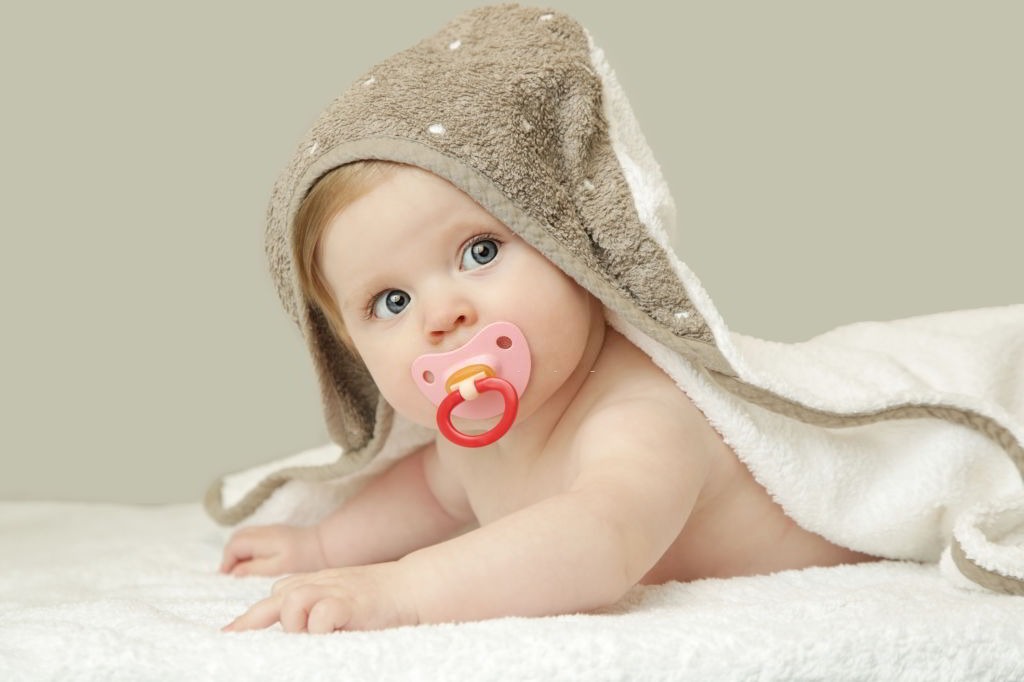
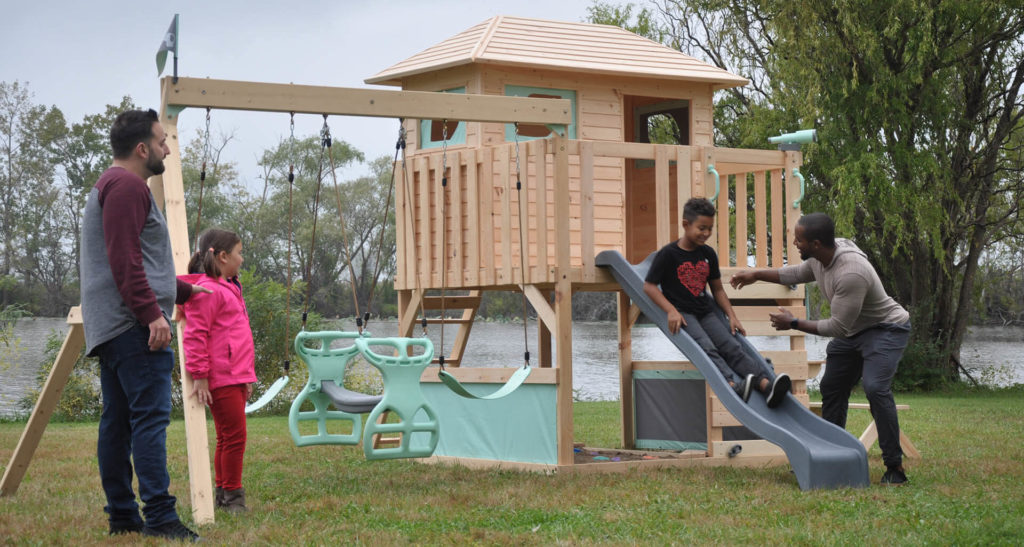
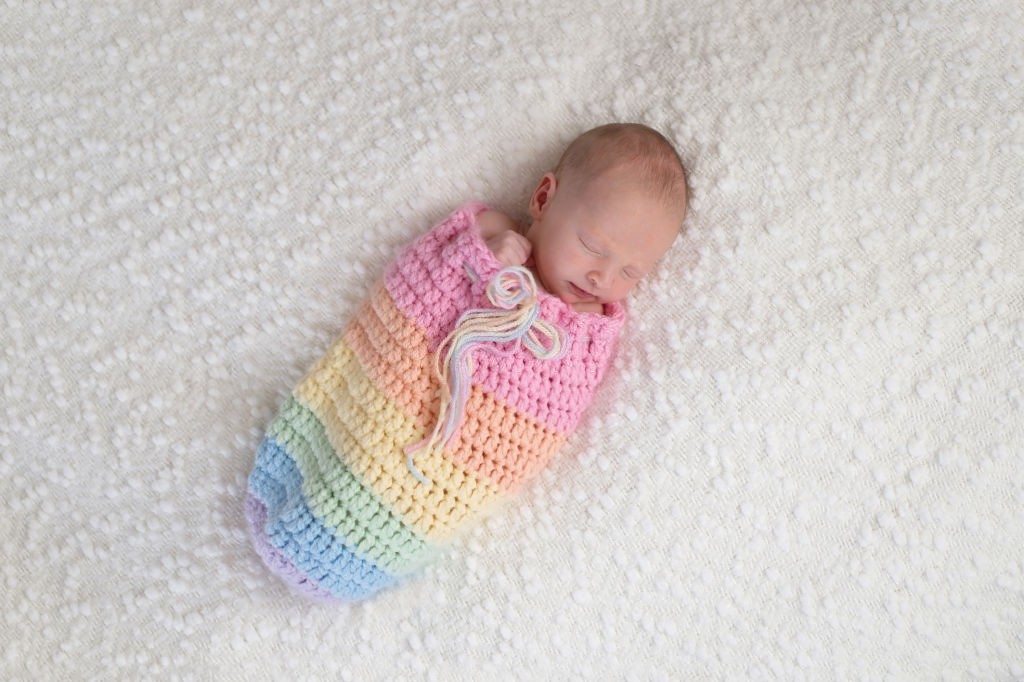
Pingback: Baby Won’t Sleep On Back – What Should We Do? - ShrewdMommy